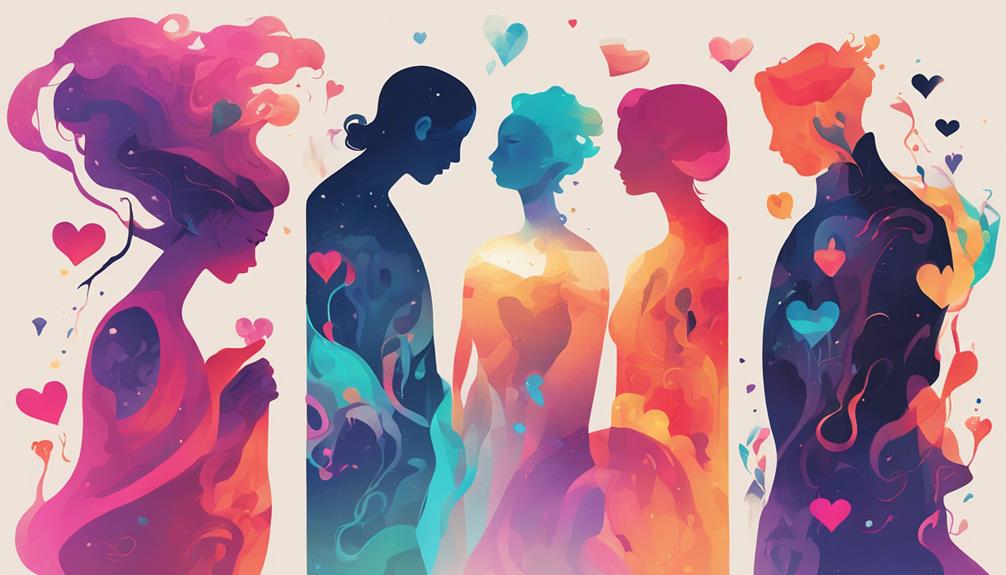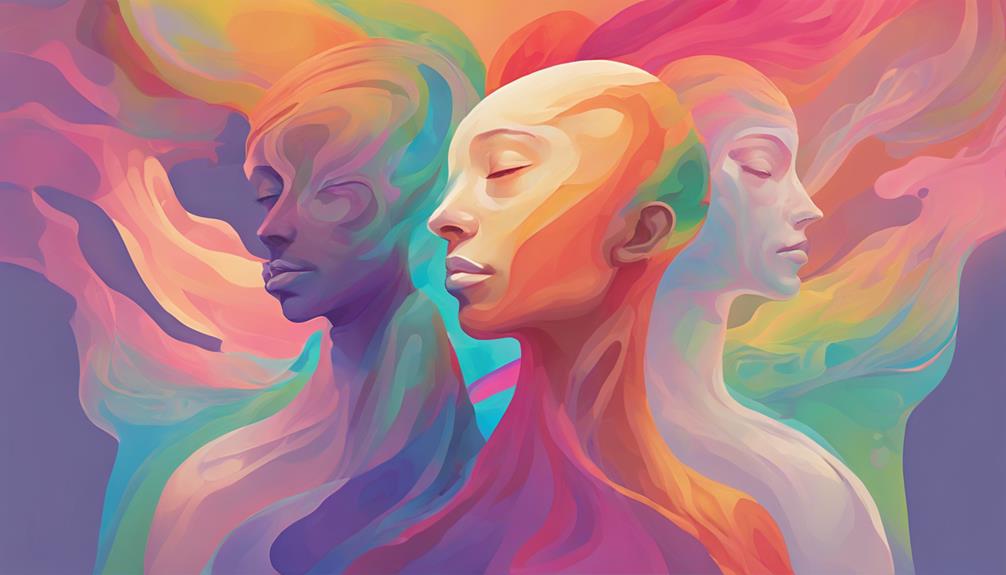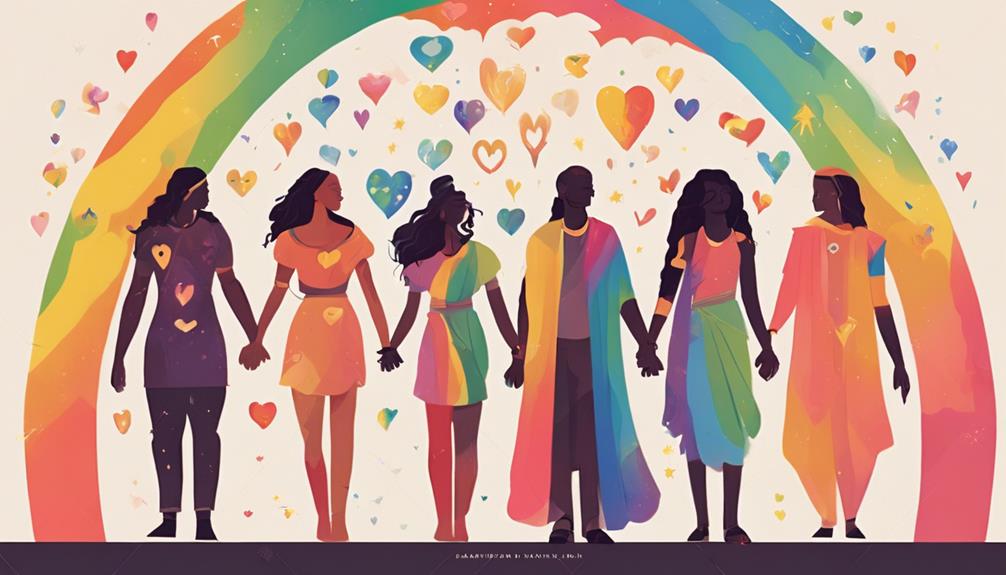Summary
- 1 Understanding gender identity
- 2 Binary and non-binary genres
- 3 Genderqueer and Genderfluid
- 4 Transgender identity
- 5 Cisgender explained
- 6 Fundamentals of Sexual Orientation
- 7 Heterosexual and Homosexual
- 8 Bisexuality and Pansexuality
- 9 Spectrum of asexuality
- 10 Aromantic Identities
- 11 Supporting Diverse Identities
- 12 Frequently asked questions
- 12.1 How can I respectfully ask someone about their pronouns?
- 12.2 What are some common misconceptions about gender identity?
- 12.3 How can workplaces support gender diversity?
- 12.4 What resources are available for parents of gender-diverse children?
- 12.5 How can schools create inclusive environments for all gender identities?
Gender identity is how you personally perceive and experience your gender, which may not coincide with your assigned sex at birth. It is your inner sense of being male, female, both or neither. Binary genders are strictly male or female, while nonbinary identities, such as genderqueer and genderfluid, cross these boundaries. Sexual orientation is about attraction-heterosexual, homosexual, bisexual, pansexual, asexual, and more. Every identity is valid and deserves respect. Supporting diversity means using the correct pronouns and fostering an inclusive environment. Dive in to better understand the broad landscape of human identity and attraction.
Understanding gender identity

Understand thegender identity begins with the acceptance that it is about how you personally experience and perceive your gender. It is an aspect deeply personal of who you are, and it's not always related to the sex you've been assigned at birth. Sometimes, the gender that feels right to you may coincide with your biological sex; other times it may not.
Think of gender identity as your inner sense Of being male, female, a combination of both or neither. It is about what you feel is true for you deep down. This may be something you know from a young age, or you may understand it later in life. Your gender identity is valid, regardless of how or when you realize it.
It is crucial to keep in mind that gender identity is distinct from thesexual orientation. While sexual orientation is about who you are attracted to, gender identity is about who you are. They are separate aspects of your identity and both deserve recognition and respect.
Binary and non-binary genres
When thinking about gender, one might first consider the traditional categories of male and female, known as genres binaries. But there is a broader spectrum that includes. non-binary identities, in which people do not fit rigidly into these two categories. Let us examine what binary and nonbinary genders mean and how they shape people's experiences.
Understanding of binary genres
The binary genders, male and female, are traditionally recognized categories, but it is important to know that they do not encompass everyone's experiences. When we talk about genres binary, we refer to the classification of people exclusively as male or female based on physical and biological attributes. This system has been dominant in many societies and cultures for centuries.
However, gender is more than a matter of biology. It is also about how individuals identify and express themselves. For many people, identifying as male or female aligns perfectly with their sense of self. They can find comfort and clarity in these traditional roles, using pronouns such as 'he' or 'she' and participating in activities or behaviors typically associated with their gender assigned at birth.
But remember, this binary view does not fit everyone. Just because someone falls into the male or female category does not mean that their experience of gender is the same as everyone else in that category. Each individual's relationship with their gender is unique and personal. Understanding binary genders is only one step in appreciating the full spectrum of human identity. Knowing this can help you support and respect each person's individual path.
Exploring nonbinary identities
Many people do not easily fit into the categories of male or female, which is where nonbinary identities come in. Nonbinary is an umbrella term for gender identities that are not exclusively male or female. If you feel like you don't fit into the traditional concepts of 'man' or 'woman,' nonbinary may resonate with you.
Nonbinary individuals may experience a variety of gender identities. Some may feel like a mix of both genders, neither, or something completely different. Understanding these identities may be easier with a quick overview:
| Term | Definition | Example |
|---|---|---|
| Genderqueer | A general term for nonnormative gender identities. | Someone who feels both male and female |
| Genderfluid | Gender identity changes over time | Feeling male one day, female the next |
| Agender | Absence of a sense of gender | Identify as gender neutral |
| Bigender | Identifying simultaneously as two genders | Feeling both male and female at the same time |
| Demiboy/Demigirl | Partially identifying with a gender | Feeling partly male, but not quite |
Genderqueer and Genderfluid

Genderqueer and genderfluid identities challenge traditional understandings of gender by embracing fluidity and nonconformity. If you identify as genderqueer, you may feel that you do not easily fit into the categories of 'male' or 'female.' Your gender identity could be a combination of both, none, or something else entirely. The term genderqueer is broad and adaptable, allowing you to define your experience.
On the other hand, if you are genderfluid, your gender identity may fluctuate over time or even from one day to the next. You may feel more masculine one day and more feminine the next, or perhaps something else entirely. Being genderfluid means that your gender experience is not fixed and can vary in different contexts.
Both genderqueer and genderfluid identities emphasize that gender is not simply a binary concept. These identities give you the freedom to express yourself in ways that feel authentic to you, without being confined to traditional gender roles. Understanding these identities can help you appreciate the wide range of human experience. Embracing who you are, whether you are genderqueer or genderfluid, can be an empowering journey of self-discovery and acceptance.
Transgender identity
Transgender identities encompass a wide range of experiences in which your gender identity is not aligned with the sex you were assigned at birth. This can mean different things to different people. For some, it may involve social evolution, medical evolution, or both. Social evolution may include changing your name, pronouns, and how you present yourself to the world. Medical evolution might involve hormone therapy or surgery to align your body with your gender identity.
Understanding transgender identities may be easier if you think about:
- Nonbinary transgender people: Some do not strictly identify as male or female.
- Transgender Men and Transgender Women: Transgender men are assigned female at birth but identify as male, while transgender women are assigned male at birth but identify as female.
- Gender Dysphoria: Some people may experience discomfort or distress because their gender identity does not match their assigned sex.
It is important to respect each person's journey and the terms they use to describe themselves. Everyone's experience is unique, and by being open to learning, you can better support friends, family, and members of the transgender community. Understanding and respect make a difference in making the world more inclusive for everyone.
Cisgender explained

When your gender identity is in line with the sex you were assigned at birth, you are considered to be cisgender. It is a term that may not be familiar to everyone, but it is important for understanding the diverse spectrum of the gender identity. If you were assigned female sex at birth and identify as a woman, or if you were assigned male sex at birth and identify as a man, you are cisgender.
Cisgender is often abbreviated to 'cis' and is derived from the Latin prefix meaning 'on this side of.' Unlike people transgender, whose gender identities differ from their sex assigned, cisgender people experience a match between their gender identity and their sex of birth. This consistency can influence how you experience the world and how others perceive you.
Understanding the term cisgender helps to recognize the privilege involved. Society often assumes that everyone's gender identity matches their assigned sex, making everyday life a little easier for cisgender people. Recognizing this can foster empathy and support for those whose experiences differ. Being aware of terms like cisgender enriches conversations about gender, making it easier to respect and support the different identities.
Fundamentals of Sexual Orientation
Now, let's dive into the concepts of sexual orientation. You will learn about different types such as heterosexuality, homosexuality, bisexuality and more. We will also examine the spectrum of attraction And how it varies from person to person.
Types of sexual orientations
Sexual preference refers to the enduring pattern of romantic or sexual attraction to others based on their gender. Understanding the different types of sexual preference can help you better understand the different ways people experience attraction. Here are some common types:
- Heterosexual: Attraction to individuals of the opposite sex. For example, a man interested in women.
- Homosexual: Attraction to individuals of the same sex. This includes gay men and lesbian women.
- Bisexual: Attraction to more than one gender, usually both men and women.
These are just a few examples, and there are many other preferences with which people identify. For example, individuals pansexuals feel attraction regardless of gender, while individuals asexuals might not feel sexual attraction at all. Each preference is valid and reflects the distinctive way in which someone might connect with others romantically or sexually.
It is crucial to keep in mind that sexual preference is a personal and intrinsic part of who someone is. Respecting and understanding these preferences promotes a more inclusive and supportive environment for everyone. By learning about these different types, you can cultivate empathy and admiration for the diverse experiences of those around you.
Understanding the spectrum of attraction
Investigating theset of attractions helps you understand the different ways in which people live and express their sexual orientation. This set includes such diverse orientations as heterosexuality, homosexuality, bisexuality, and pansexuality. Each of these represents different ways in which people may feel attracted to others, whether of the opposite sex, same sex, both, or regardless of gender.
It is important to keep in mind that sexual orientation is about who you are romantically or sexually attracted to. For example, a person heterosexual Is attracted to someone of the opposite sex, while a person homosexual Is attracted to someone of the same sex. The bisexual individuals feel attraction to men and women, while the pansexual individuals Are attracted to people regardless of gender.
Understanding this spectrum can help you appreciate the complexity and individuality of the personal experiences. People may also identify as asexual, which means they do not experience sexual attraction at all, but they may still have romantic feelings. Recognizing these different orientations fosters empathy and respect for each person's personal journey. Learning about theset of attractions, you will be better able to support friends, family and yourself in navigating the rich landscape of the human sexuality.
Heterosexual and Homosexual
Throughout history, individuals have been attracted to people of either the opposite sex, known as heterosexuality, or the same sex, known as homosexuality. These two orientations are quite familiar to most of us, but understanding their underpinnings is critical to appreciating the broader spectrum of sexual orientations.
Heterosexuality, or being heterosexual, means being attracted to individuals of the opposite sex. For example, a man who has affection for a woman or a woman who has affection for a man. On the other hand, homosexuality, or being gay or lesbian, means being attracted to individuals of the same sex. For example, a man who feels affection for another man or a woman who feels affection for another woman.
Here are some key points to help you better understand these orientations:
- Heterosexuality: The most common sexual orientation, often represented in mainstream romantic narratives and media.
- Homosexuality: Historically marginalized but gaining increasing acceptance in modern society.
- Cultural influence: Both orientations have been perceived differently through various cultures and historical periods.
Understanding these orientations helps promote a more inclusive and empathetic society. It is important to respect everyone's feelings and experiences, creating a more compassionate world for all.
Bisexuality and Pansexuality
When it comes to bisexuality e pansexuality, it is important to understand their definitions and key differences. Bisexuality typically means attraction to more than one gender, while pansexuality means attraction to people regardless of gender. Debunking common misunderstandings can help you better understand the unique experiences of people who identify with these orientations.
Definitions and key differences
Understanding the key differences between bisexuality and pansexuality can help clarify how individuals experience and express their sexual and gender attractions. Although both orientations involve attraction to more than one gender, they are not exactly the same thing.
Bisexuality is typically defined as attraction to two or more genders, but not necessarily to all genders. Those who identify as bisexual might experience attraction to both men and women, or to people of their own and other genders. The term is not limited to just two genders and can be fluid in its meaning.
Pansexuality, on the other hand, means attraction to individuals regardless of their gender. Pansexual people are often described as "gender blind," meaning that they do not consider gender in relation to attraction.
Here are some key points to keep in mind:
- Bisexuality: Involves attraction to two or more genders.
- Pansexuality: Involves attraction regardless of gender.
- Flexible Definitions: Both terms can be adaptive and personal.
Understanding these definitions and their nuances can help you better understand the diversity of human attraction and the importance of individual identity.
Common misunderstandings clarified
Many people mistakenly believe that bisexuality and pansexuality are the same thing, but there are important differences between the two. Bisexuality means being attracted to two or more genders. This could include attraction to both men and women, or to people of one's own gender and other genders. The key point is that bisexuality recognizes and includes attraction to multiple genders, but not necessarily all of them.
On the other hand, pansexuality means being attracted to people regardless of their gender. Pansexual people often say they love "hearts, not parts," which means they are attracted to the person themselves, not their gender identity. This can include people who identify as nonbinary, genderqueer or any other gender.
Understanding these differences can help you more accurately respect and confirm people's identities. By learning the nuances, you avoid making assumptions and show that you are supportive and informed. It is important to listen to how people describe their experiences, as personal definitions can vary. Being open and curious is critical to fostering a more inclusive environment for all.
Spectrum of asexuality

The spectrum of asexuality encompasses a range of experiences, from those who feel no sexual attraction at all to those who may feel it only in specific circumstances. Understanding this can help you appreciate the diversity within the asexual community. People on the asexuality spectrum might identify in various ways, depending on their unique experiences and feelings about sexual attraction.
Here are some key identities within the spectrum:
- Asexual: Individuals who generally do not feel sexual attraction to anyone.
- Graysexual: Those who rarely experience sexual attraction or only under certain conditions.
- Demisexual: People who experience sexual attraction only after forming a deep emotional bond with someone.
Navigating relationships and social interactions can be different for those on the asexual spectrum. It is important to respect their experiences and not pressure them to conform to societal expectations regarding sexuality. Remember, everyone's journey is unique, and recognizing these identities fosters a more inclusive environment.
If you are on the spectrum of asexuality or know someone who is, understanding and communication are essential. This knowledge can help you support and respect the different ways people experience and express their sexual orientation.
Aromantic Identities
In the field of romantic orientation, aromantic identities describe individuals who feel almost no romantic attraction toward others. If you identify as aromantic, you may not feel the inclination to form romantic relationships, but you can still have deep and meaningful connections in your life. Aromanticism is a spectrum, and people may experience it in different ways.
Here is a quick look at the different aromatic identities:
| Identity | Description | Key Features |
|---|---|---|
| Aromantic | Does not feel romantic attraction | No propensity for romantic relationships |
| Demiromantic | Experience romantic attraction only after strong emotional connection | Casual romantic feelings after close bonding |
| Greyromantic | Experience romantic attraction rarely or weakly | Rare or ambiguous romantic feelings |
| Lithromantic | He feels romantic attraction but does not need it to be reciprocated | He prefers not to have romantic feelings returned |
| Aroflux | It fluctuates between different levels of romantic attraction | Romantic interest varies over time |
Understanding aromatic identities can help you appreciate the different ways people experience relationships. It is important to respect everyone's unique orientation and not assume that romantic attraction is universal. By doing so, you will foster more inclusive and supportive environments for everyone.
Supporting Diverse Identities

Creating an inclusive environment starts with understanding and respecting different gender identities. You can make a significant impact by being open-minded and eager to learn. Recognizing that everyone's experience is unique and valuable is critical. Here are some practical steps you can follow:
- Educate yourself: Take time to inform yourself about different gender identities and expressions. Knowledge is the key to empathy and respect.
- Uses Proper Pronouns: Always ask and use pronouns that correspond to someone's identity. Demonstrates respect and recognition of their identity.
- Promote Inclusiveness: Become an advocate for inclusive policies and practices in the workplace, school or community.
Being supportive does not require understanding every detail immediately. It is about showing respect and a willingness to learn. When you make mistakes-and it will happen-apologize, correct yourself and move on. It is acceptable to ask questions in a respectful manner and seek guidance. Remember, creating a supportive environment is an ongoing process, and your efforts can make a difference. By following these steps, you are helping to build a world where everyone feels recognized, valued and respected.
Frequently asked questions
How can I respectfully ask someone about their pronouns?
When you want to ask some of their pronouns, simply be kind And direct. You might say, 'Hi, I want to make sure I address you in the correct way. What are your pronouns?" It is a simple question That shows that you care about being respectful. Remember, it is always better to ask than to assume. This small step helps create a more inclusive and understanding environment for everyone.
What are some common misconceptions about gender identity?
Some common misconceptions about gender identity include thinking it is the same as sexual orientation or believing there are only two genders. People often assume someone's gender based on appearance, but gender is a personal and internal experience. Another myth is that gender identity is a choice or a phase, but it is a deeply ingrained part of who someone is. Understanding and respecting these differences is essential.
How can workplaces support gender diversity?
To support the gender diversity workplace, you need to start by educating everyone about different gender identities. Make sure policies are inclusive, such as having gender-neutral bathrooms. Use the correct pronouns And encourages others to do the same. Create a safe environment where everyone feels comfortable expressing themselves. Provide resources and support groups. It's about respect and understanding to make all people feel valued.
What resources are available for parents of gender-diverse children?
If you are a parent of a gender-diverse boy or girl, there are many resources that can help you. Take a look at organizations such as PFLAG, which offers support groups and educational materials. The Trevor Project Provides crisis intervention and suicide prevention. Websites such as. Gender Spectrum offer webinars and guides. Local LGBTQ+ centers can also be a great resource. Don't hesitate to seek out the support you need.
How can schools create inclusive environments for all gender identities?
To create an inclusive environment, schools should start by educating staff and students about the gender diversity. It is important to use the correct pronouns and allow students to freely express their gender identity. Implement the gender-neutral restrooms and update policies to protect the gender-diverse students are also key steps. Encourage open conversations and offer support groups to ensure that everyone feels safe and respected.
